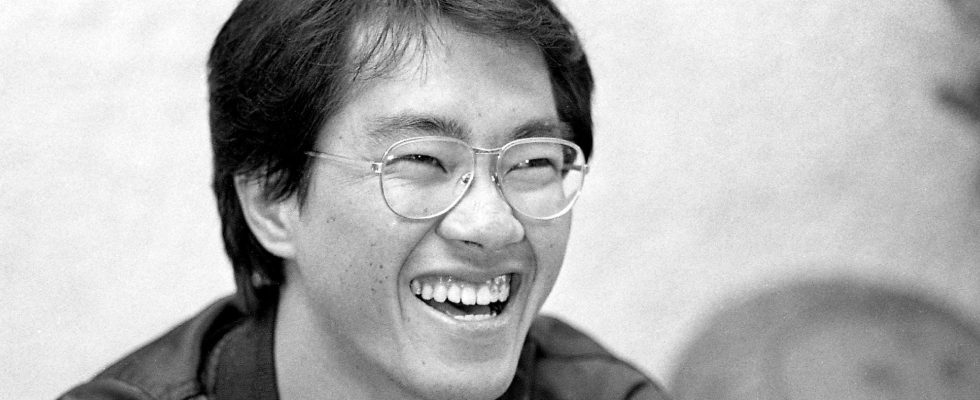On social networks, tributes to the “manga genius” are multiplying this Friday March 8. Mangaka Akira Toriyama, creator of the world-famous series “Dragon Ball” and “Dr Slump”, died at the age of 68 from a subdural hematoma on March 1, announced his publishing house and his studio. His best-known work, “Dragon Ball”, has accompanied several generations of children and adolescents, generating multiple adaptations, on television, in the cinema, in video games…
Born in Nagoya, in central Japan, in 1955, Akira Toriyama was best known for the manga “Dragon Ball”, created in 1984 and loosely inspired by a 16th century Chinese novel, recounting the life and adventures of the prodigy martial arts Son Goku since his childhood. For L’Express, Julien Bouvard, lecturer in Japanese studies at Jean Moulin Lyon 3 University, traces the story of global success.
L’Express: The manga “Dragon Ball” has more than 260 million copies sold around the world. How to explain such success?
Julien Bouvard: “Dragon Ball” had incredible success outside of Japan. It is the first manga that has been so widely translated and distributed abroad. Moreover, of the approximately 300 million copies sold, almost half must have been distributed abroad.
Dragon Ball is a fairly intelligent alloy of Japanese, even Asian elements (Editor’s note, in reality “Dragon Ball” is taken from a Chinese legend), which mixes martial arts, with an influence of Jackie Chan, science fiction, and a “Terminator” aspect, notably through time travel. “Dragon Ball” is a sort of melting pot of many facets of global pop culture, reshaped to make a narrative that lends itself very well to foreign language translation. “Dragon Ball” is the synthesis of different influences, well beyond Japan, and this is what partly explains its success, as well as its accessibility. Moreover, Akira Toriyama was less a fan of manga than of international cinema. In turn, this can explain the franchise’s success in the West.
What revolutionized it for it to be exported so much?
“Dragon Ball” is first and foremost a fighting manga, but with an exceptional layout. At the time, his composition of the page to transcribe the fights was unprecedented, with quite interesting uses of the plate. He uses time as a weapon in order to deconstruct gestures, movements… In this, he was innovative. It is perhaps the one who was able to add a form of purity in the layout of mangas, absent until then. In comparison, combat manga from the same era were much more bloody, messy, and with an abundance of artifice.
Akira Toriyama is originally more of an illustrator than a manga artist, which explains why his works are cleaner and more readable. All this makes “Dragon Ball” an accessible manga and it is a dimension that allows us to understand today why it had such success around the world. Through his way of telling and drawing, Akira Toriyama democratized manga.
“Dragon Ball” by Akira Toriyama is the manga that helped popularize Japanese manga and cartoons. What was the influence of “DB” on the manga?
Generations of mangakas have been suckled on “Dragon Ball” and “Dr Slump”, Toriyama’s other iconic work, better known in Japan. This morning, we see the various tributes paid to Toriyama: dozens of designers explain that they would not have become ones without his influence. Among them, Katsura, or even Oda, the author of “One Piece” and Masashi Kishimoto, the author of “Naruto”. Today, they feel like they have lost a father, a role model. We must understand that when this generation of mangaka started out, they could not avoid reading “Dragon Ball”, because it is the ultimate reference.
It is a work that has stood the test of time, knowing how to renew itself with series, cartoons, films…
“Dragon Ball” also owes its success to this. That is to say that it is a transmedia work, adapted to television, to cinema and which has had great success through video games as well.
Today, what is the weight of manga in France?
Manga has been published in France for 30 years and now the weight of manga represents approximately half of the comic book market in volume. The first success dates from 1992, when the manga “Dragon Ball” was published in French. There is a long history of manga adaptation in France to reach the French public. The first editions of “Dragon Ball” in France are read for example from left to right, then, gradually, we adopt the original form, that is to say from right to left, and respecting the edition almost to the letter. There is a sort of digestion, of adaptation of the manga by the French to its original form, including in the translations, which did not quite fit at first.
.
